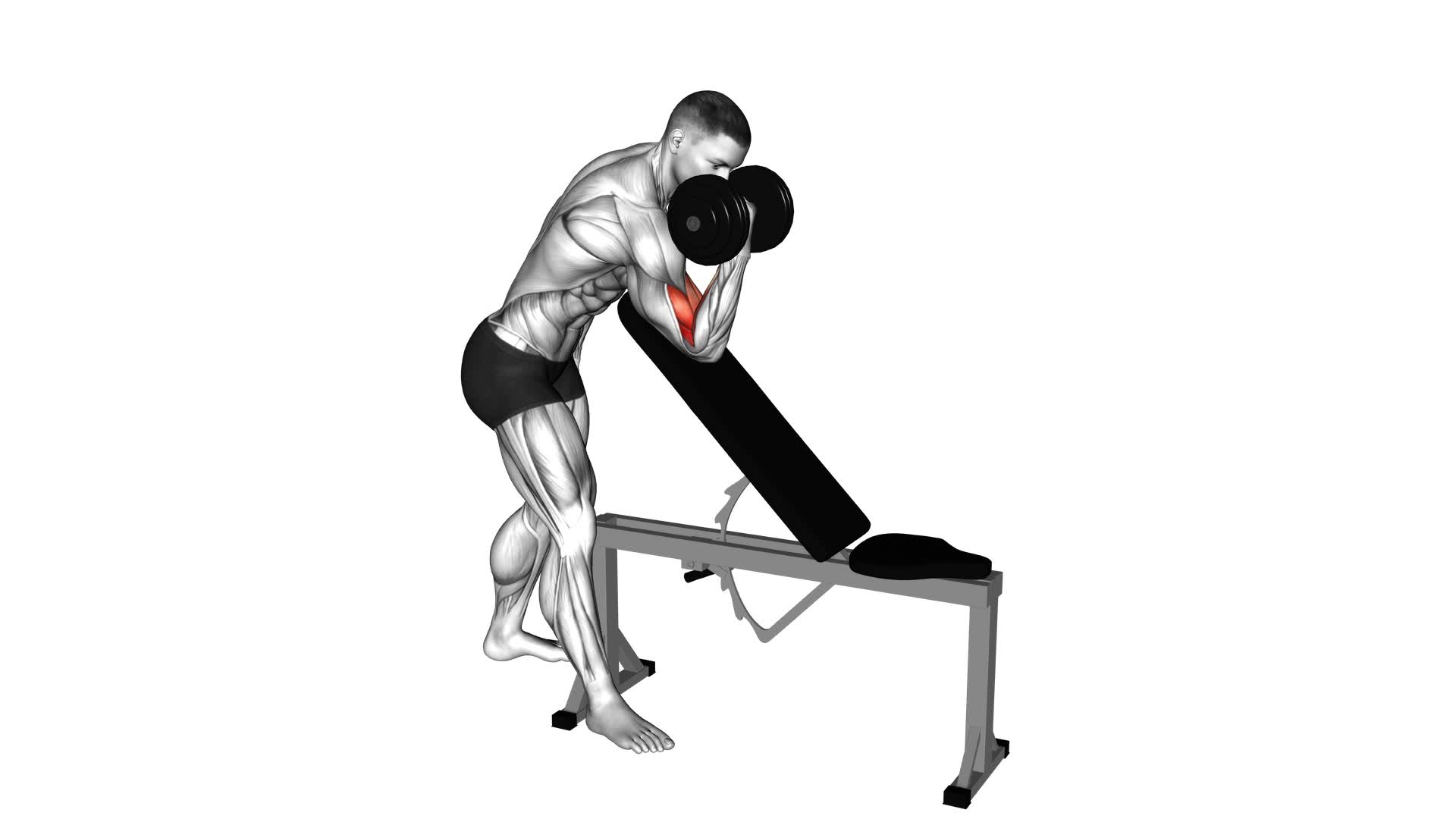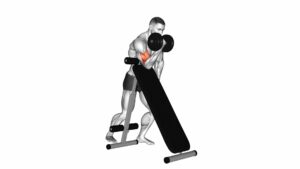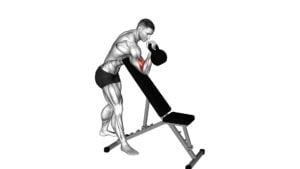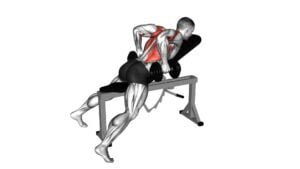Dumbbell Standing One Arm Curl Over Incline Bench – Video Exercise Guide & Tips

Get ready to pump up those biceps with the dumbbell standing one arm curl over incline bench exercise!
Watch This Exercise Video
In this video exercise guide, you'll learn the proper form and technique, how to set up the incline bench, and choose the right dumbbell weight.
Follow our step-by-step guide for maximum results and injury prevention.
So grab your dumbbell and get ready to sculpt those arms like never before!
Key Takeaways
- Use controlled and deliberate movements throughout the exercise.
- Beginners can use lighter dumbbells or perform the exercise with both arms simultaneously.
- Adjust the incline angle of the bench to your desired level for proper alignment and support.
- Start with a conservative weight and gradually increase as you become more comfortable.
Proper Form and Technique
To perform the Dumbbell Standing One Arm Curl Over Incline Bench exercise with proper form and technique, you should use an incline bench set at a comfortable angle. This exercise is great for targeting your biceps and building arm strength. When executing this exercise, it's important to maintain proper form to maximize its benefits and prevent injury.
One common mistake to avoid is using excessive momentum to lift the dumbbell. This not only reduces the effectiveness of the exercise but also puts unnecessary strain on your muscles and joints. Instead, focus on controlled and deliberate movements throughout the entire range of motion.
Additionally, variations and modifications can be made to cater to your specific fitness level and goals. For beginners, using lighter dumbbells or performing the exercise with both arms simultaneously can help build strength and improve coordination. On the other hand, advanced individuals can increase the resistance by using heavier weights or incorporating pauses at the top of the movement for an added challenge.
Now that you know the proper form and technique for the Dumbbell Standing One Arm Curl Over Incline Bench exercise, let's move on to setting up the incline bench to ensure optimal positioning and stability.
Setting Up the Incline Bench
Now that you know the proper form and technique for the Dumbbell Standing One Arm Curl Over Incline Bench exercise, let's discuss how to set up the incline bench for optimal positioning and stability.
Setting up the equipment correctly is crucial to ensure a safe and effective workout.
To begin, adjust the incline angle of the bench to your desired level. Most incline benches have multiple settings, allowing you to vary the angle according to your preference. Start with a moderate angle, around 45 degrees, and adjust as needed based on your comfort level and fitness goals.
Next, position the incline bench so that it's stable and secure. Ensure that the bench is on a flat surface and that all legs are firmly planted on the ground. This will prevent any wobbling or instability during the exercise.
Once the bench is properly set up, you can proceed to adjust the seat and backrest to ensure proper alignment. The seat should be adjusted so that your feet are firmly planted on the ground, and the backrest should provide support for your lower back.
Choosing the Right Dumbbell Weight
Once you have properly set up the incline bench, it's time to determine the appropriate dumbbell weight for the Dumbbell Standing One Arm Curl Over Incline Bench exercise. Choosing the right dumbbell weight is crucial to ensure an effective and safe workout. Here are some tips to help you with dumbbell weight selection and avoid common mistakes:
- Start with a conservative weight: It's always better to start with a lower weight and gradually increase it as you become more comfortable with the exercise. This will help you maintain proper form and reduce the risk of injury.
- Consider your fitness level: Your fitness level will play a significant role in determining the appropriate dumbbell weight. If you're a beginner, start with lighter weights and gradually progress. If you're more advanced, you may need to use heavier weights to challenge your muscles.
- Focus on proper form: It's important to prioritize proper form over heavy weights. If you find yourself sacrificing form to lift a heavier weight, it's a sign that you should decrease the dumbbell weight. Maintaining proper form will help you target the right muscles and get the most out of the exercise.
Step-by-Step Guide to the Exercise
Start by positioning yourself on the incline bench with the dumbbell in your hand. Make sure the bench is set at a 45-degree angle to engage your upper chest muscles. Place your feet firmly on the ground, shoulder-width apart, for stability.
To begin the exercise, fully extend your arm holding the dumbbell towards the floor. This is your starting position. Keep your back straight and core engaged throughout the movement.
Next, slowly lift the dumbbell towards your shoulder by flexing your elbow. Focus on keeping your upper arm stationary and only moving your forearm. Exhale as you curl the weight up.
Pause for a brief moment at the top, squeezing your bicep muscles. Then, slowly lower the dumbbell back to the starting position, inhaling as you do so. Repeat for the desired number of repetitions.
The incline bench adds an extra challenge to the exercise as it targets your upper chest muscles, in addition to your biceps. This variation can help improve overall upper body strength and muscle definition.
Incorporating variations of standing one arm curls, like the incline bench exercise, into your workout routine can provide several benefits. It helps to prevent muscle imbalances, enhances grip strength, and allows for greater range of motion compared to seated or standing curls. Remember to start with a weight that challenges you but still allows for proper form. As you progress, you can gradually increase the weight to continue challenging your muscles.
Tips for Maximizing Results and Preventing Injury
To maximize your results and prevent injury, use proper form and technique while performing the dumbbell standing one arm curl over incline bench exercise. Here are some tips to help you achieve this:
- Maintain proper posture: Stand with your feet shoulder-width apart and keep your back straight throughout the exercise. This will help prevent muscle strain and maintain stability.
- Engage your core: Keep your abdominal muscles tight and engaged to provide stability and support to your spine. This will help prevent injury and improve your overall performance.
- Use controlled movements: Avoid using momentum to lift the weights. Instead, focus on controlled and deliberate movements, emphasizing the contraction of your biceps. This will maximize muscle engagement and minimize the risk of injury.
In addition to maintaining proper form, it's important to pay attention to your breathing technique. Proper breathing can help prevent muscle strain and enhance your overall performance. Remember to exhale during the lifting phase of the exercise and inhale during the lowering phase. This will improve oxygen flow to your muscles and provide them with the necessary nutrients for optimal performance.
Frequently Asked Questions
How Many Sets and Reps Should I Do for the Dumbbell Standing One Arm Curl Over Incline Bench Exercise?
To determine the number of sets and reps for the dumbbell standing one arm curl over incline bench exercise, consider your fitness goals and current strength level. Gradually increase the weight as you progress to challenge your muscles.
Avoid common mistakes like using momentum or lifting too heavy. Start with a moderate weight and aim for 3-4 sets of 8-12 reps per arm.
Listen to your body and adjust accordingly for optimal results.
Can I Substitute the Incline Bench With a Regular Flat Bench for This Exercise?
Yes, you can substitute the incline bench with a regular flat bench for the dumbbell standing one arm curl exercise.
However, using an incline bench offers several benefits. It increases the range of motion and targets the biceps from a different angle, leading to better muscle activation and growth.
Additionally, incorporating variations such as alternating arms or using a preacher curl bench can provide further challenges and target different muscle fibers.
What Muscles Does the Dumbbell Standing One Arm Curl Over Incline Bench Target?
The dumbbell standing one arm curl over incline bench primarily targets your biceps, specifically the long head. Secondary muscles worked include the brachialis and brachioradialis. If you don't have an incline bench, you can use a regular flat bench or even a stability ball to perform this exercise.
Remember to maintain proper form and control throughout the movement to maximize muscle engagement and prevent injury.
Is It Normal to Experience Some Discomfort in the Wrists During This Exercise?
If you're experiencing discomfort in your wrists during the dumbbell standing one arm curl over incline bench exercise, it's not uncommon.
To modify the exercise for wrist discomfort, try using wrist wraps or straps for added support.
Additionally, make sure to maintain proper wrist positioning by keeping them straight and aligned with your forearms throughout the movement.
This can help alleviate any strain or discomfort you may be feeling.
How Long Should I Wait Between Sets When Performing This Exercise?
When performing this exercise, it's important to give your muscles enough time to recover between sets. Resting between sets allows your muscles to replenish energy and reduces the risk of injury.
The optimal rest time between sets can vary depending on your fitness level and goals. It's generally recommended to rest for about 1-2 minutes between sets for this exercise. However, it's always best to listen to your body and adjust the rest time accordingly.
Conclusion
In conclusion, the dumbbell standing one arm curl over incline bench is an effective exercise for targeting the biceps.
By using proper form and technique, setting up the incline bench correctly, and choosing the right dumbbell weight, you can maximize your results and prevent injury.
This exercise is a great addition to any upper body strength training routine.

Author
Years ago, the spark of my life’s passion ignited in my mind the moment I stepped into the local gym for the first time. The inaugural bead of perspiration, the initial endeavor, the very first surge of endorphins, and a sense of pride that washed over me post-workout marked the beginning of my deep-seated interest in strength sports, fitness, and sports nutrition. This very curiosity blossomed rapidly into a profound fascination, propelling me to earn a Master’s degree in Physical Education from the Academy of Physical Education in Krakow, followed by a Sports Manager diploma from the Jagiellonian University. My journey of growth led me to gain more specialized qualifications, such as being a certified personal trainer with a focus on sports dietetics, a lifeguard, and an instructor for wellness and corrective gymnastics. Theoretical knowledge paired seamlessly with practical experience, reinforcing my belief that the transformation of individuals under my guidance was also a reflection of my personal growth. This belief holds true even today. Each day, I strive to push the boundaries and explore new realms. These realms gently elevate me to greater heights. The unique combination of passion for my field and the continuous quest for growth fuels my drive to break new ground.







